
Katelynn Ulmer - Ghanaian Asafo Flags: A Virtual Exhibition

Image: Example of Category 1 Asafo flag. Image Credit: karuncollection.com.
Textile collector Karun Thakar has recently curated an online exhibition showcasing over 200 Ghanaian Asafo flags. This is a continuation from Thakar’s African Textiles exhibition at the Brunei Gallery, School of Oriental and African Studies in London. The flags featured span from the early 19th century to the late 1970s and illustrate pre- to post-independence Ghanaian visual traditions. Several of the flags in this collection are merely fragments, but photographer Desmond Brambley has digitally restored them for this exhibition. Duncan Clarke has written an accompanying article in which he details the history of Asafo flags and how their visual language shifts over time.
The Asafo flags were created by the Fante militia companies of Western Ghana using appliqué and embroidery techniques. Appropriated from European naval ensigns and national flags, the form was adapted to explore local values and indigenous artistic processes. The flags in this exhibition are separated into three categories. Category 1 features flags from the 19th century and early 1900s that were very minimal in design. The Union Jack canton was typically placed in the flag’s upper corner. If borders were utilized, they were narrow and simple. Central imagery was small and placed upon a plain background of either red, black, dark blue, or white.

Image: Example of Category 2 Asafo flag. Image Credit: karuncollection.com.
Category 2 spans from the 1920s to just before Ghana’s Independence in 1957. Clarke describes these as the ‘golden age’ in Asafo flags. The Union Jack cantons utilized on these flags are much larger and the borders much more elaborate. Large central motifs are depicted here through the use of paper patterns that represent human and animal figures. Following Ghana’s Independence in 1957, Category 3 showcases flags that replace the Union Jack with the new Black Star flag. A wider range of colours can be seen implemented here, the most popular being turquoise and purple.

Image: Example of Category 3 Asafo flag. Image Credit: karuncollection.com.
To view and learn more about this online collection of over 200 Asafo flags please visit www.karuncollection.com.
